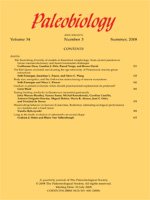One of the greatest challenges in using faunal assemblages to make ecological or paleoecological interpretations is determining the spatial scale over which such analyses are applicable. As a result, it has been difficult to use these assemblages to test hypotheses about spatial and temporal variability in populations. Here we show that it is possible to use strontium (Sr) isotopes from bones and vegetation to statistically constrain the area sampled in two Holocene predator accumulations in northeastern Yellowstone National Park, Wyoming. Previous studies have used these sites to elucidate local population responses to climatic change, by assuming that the specimens originated within ∼5 km of the site. We used Sr analyses to construct a likelihood curve that describes the probability that our samples were collected within a given radius of each site. Our results indicate that the specimens in both sites were derived from non-overlapping populations and that the collection radius has not changed detectably over the past 3000 years. This work underscores the promise of this technique for ascribing source areas to paleontological, biological, and ecological specimens.
How to translate text using browser tools
1 June 2003
Mapping the origin of faunal assemblages using strontium isotopes
Stephen Porder,
Adina Paytan,
Elizabeth A. Hadly
ACCESS THE FULL ARTICLE





